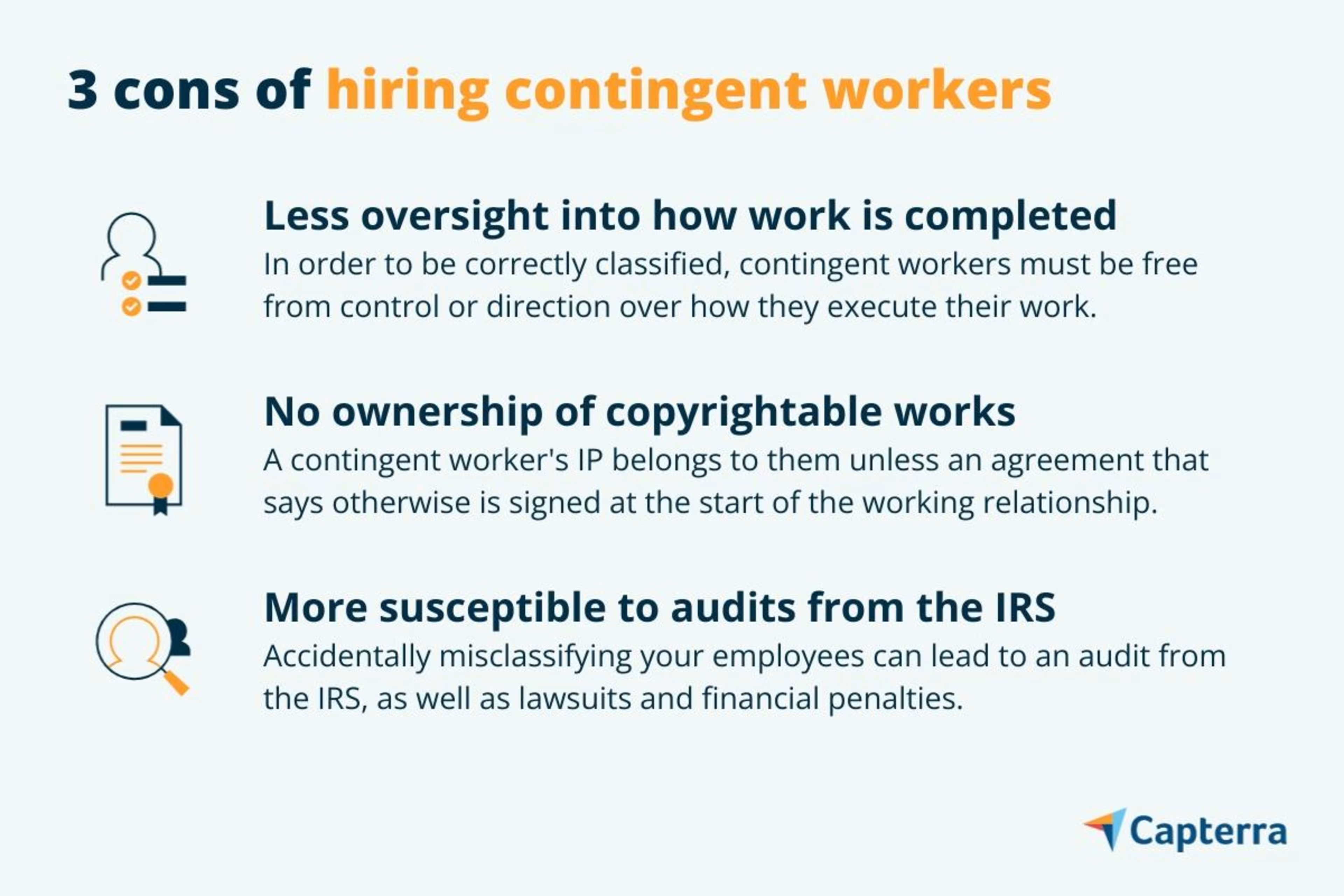Considering hiring contingent talent? Know the pros and cons first.
Gartner research from late last year found that an overwhelming majority (83%) of organizations are expected to increase their use of contingent workers (full content available to clients). That leaves only 17% of businesses that aren't planning to take advantage of contingent workers—so, if you’re a part of that minority, you may be wondering: What am I missing out on?
Well, as the person in charge of staffing at your business, you’re probably aware of the ongoing talent shortage that’s making it difficult for recruiters to fill open seats. And if you’re not, consider this: In a recent Capterra survey, we asked employees with recruiting responsibilities to rate the difficulty of finding, attracting, and recruiting job seekers to their employer on a scale from 1 (not difficult at all) to 7 (extremely difficult).
The majority of them rated their experience as a 5...and nearly 10% chose a 7.
But one thing you may not be aware of is that there are noteworthy benefits that come with hiring contingent workers, one of which is fast access to labor. If your interest is piqued, keep scrolling to learn more about pros and cons of hiring contingent talent, starting with the basics: What is a contingent workforce, exactly?
What is a contingent workforce?
A contingent workforce is made up of temporary workers who are hired on a contract or project basis for a business. Unlike direct hires, they are not employed by the organization they work for; instead, they are placed on demand by a staffing agency. While contingent workers are usually brought on to help with a specific project or season of work, it's not uncommon for them to commit to 12-, 18-, or 24-month contracts.
Short on time? We get it. For a reader’s digest version of the content below, check out this short video:
Is a contingent worker different from an independent contractor?
In short, yes. Are you familiar with the idea that every square is a rectangle, but not every rectangle is a square? The same can be said for contract workers and contingent workers; every independent contractor is a contingent worker, but not every contingent worker is an independent contractor. This is because independent contractors are considered self-employed, while contingent workers can be employed full time by a staffing agency.
The pros of hiring contingent talent

Pro #1: Staffing flexibility
Depending on the industry your business is in, staffing needs may fluctuate throughout the year. For example, retailers often need to hire help around the holiday season. Hiring contingent workers is a strategy that can be used to meet temporarily increased staffing demands, and because contingent staff are hired for a set period of time, employers don’t have to continue to pay them after the work is done.
Pro #2: Fast access to specialized skills
In a survey conducted by Capterra last year, we asked 300 workers with recruiting responsibilities how long it is taking for them to fill job openings. 53% responded that it was taking longer than usual, and an additional 9% claimed it was taking the longest amount of time they’ve seen during their tenure.
During a time when hiring full-time employees (a process that already takes between one to two months on average) is dragging on, contingent talent can be hired quickly with the skills you need ready to go.
Pro #3: Less fixed expenses
Reduced costs is one of the main reasons why employers opt for contingent labor. Employers have to pay U.S. Social Security and payroll taxes for every full time employee, and in addition to their salary, full-time employees are usually provided with benefits such as health insurance, matching 401k contributions, and paid time off.
By comparison, social security and payroll taxes are not required for contingent workers (unless local laws explicitly say so). They also do not receive benefits, which means that in most cases, hiring a contingent worker is a fraction of the cost of hiring a new full time employee.
Ready to hire a recruiting agency for your business needs? Browse our list of companies in the following areas:
The cons of hiring contingent talent

Con #1: Less oversight into how work is completed
If the nature of the work you need additional help with is nuanced or highly specific to your business, it’s best to hire a full time employee who can be trained on the ins and outs of the job. This is because in order to be correctly classified, contingent workers must be free from the control and direction of the organization they’re working for in regards to how they complete their work.
In fact, the Internal Revenue Service (IRS) lists behavioral control as one of the best indicators for determining whether a worker is an employee or an independent contractor. Their website says: “A worker is an employee when the business has the right to direct and control the work performed by the worker, even if that right is not exercised.”
Con #2: No ownership of copyrightable works
If a contingent worker creates a copyrightable piece of work during their service with your organization, your business will not outright own the intellectual property. In the U.S., the “Works Made for Hire” doctrine states that in order for an independent contractor or third party consultant’s work to be considered a work made for hireCon #3: More susceptible to audits from the IRS
Perhaps the most important con of hiring contingent workers is the risk of misclassification. Misclassification occurs when an organization incorrectly categorizes employees as independent contractors or contingent workers. This can lead to an audit from the IRS, and ultimately, lawsuits or heavy financial fines.
For example, in the early 2000s, Microsoft was a part of a class action lawsuit that resulted in thousands of freelance and temporary workers being reclassified as employees. The company had hired the workers as temps, but kept them employed for over a year while refusing to provide them benefits. The settlement cost the company $97 million.
In rare cases, misclassification violations are intentionally committed by organizations acting in bad faith. More frequently though, these violations are the results of businesses not understanding the terms of contingent employment.
Which leads us to our next point: If you’re considering using contingent or contract workers as a workforce solution, make sure you’ve got the resources in the box below bookmarked.
Capterra Tools and Tips
All of the information you need to determine whether contingent staffing could work for your business is one click away.
First, check out Is Contingent Staffing Right For Your Organization?, for help determining whether this staffing strategy is a good fit for your business, as well as next steps for getting started.
If you plan on hiring contingent or contract employees, take time to understand how the IRS distinguishes between different types of employees.
Use Baker McKenzie’s Contingent Worker Misclassification Risk Map & Comparison Tool for a step-by-step approach to correctly classifying workers

